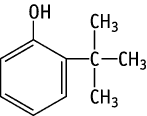

2-tert-Butylphenol was studied for oral toxicity in rats in a 28-day repeat dose toxicity test at 0, 4, 20, 100, and 500 mg/kg.
Ataxic gait was observed in the 500 mg/kg group, and salivation was noted in the 100 and 500 mg/kg groups. Organ weight measurement revealed an increase in relative liver weight in the 500 mg/kg group. These changes disappeared after withdrawal. The NOEL is considered to be 20 mg/kg/day for both sexes.
Genotoxicity of 2-tert-butylphenol was studied by a reverse mutation test in bacteria and a chromosomal aberration test in cultured Chinese hamster lung (CHL/IU) cells.
2-tert-Butylphenol was not mutagenic in Salmonella typhimurium TA100, TA1535, TA98, TA1537 and Escherichia coli WP2 uvrA, with or without an exogenous metabolic activation system.
2-tert-Butylphenol induced structural and numerical chromosomal aberrations in CHL/IU cells after short-term treatment with an exogenous metabolic activation system.
| Purity | : | 99.97 % |
| Test species/strain | : | Rat/Crj:CD(SD)IGS |
| Test method | : | OECD Test Guideline 401 |
| Route | : | Oral(gavage) |
| Dosage | : | 0(vehicle), 500, 1000, 2000 mg/kg |
| Number of animals/group | : | Males, 5; females, 5 |
| Vehicle | : | Olive oil |
| GLP | : | Yes |
Test results:
Clinical signs observed were as follows: ataxic gait, abnormal gait, decrease in locomotor activity, tremor, irregular respiration, crouching, prone or lateral position, lacrimation, and hypothermia. Body weights were decreased in males of the 1000 and 2000 mg/kg groups on Day 4. Pathological changes were mainly observed in the forestomach and glandular stomach.
The LD50 values were 1231 mg/kg for males and 1414 mg/kg for females.
| Purity | : | 99.97 % |
| Test species/strain | : | Rat/Crj:CD(SD)IGS |
| Test method | : | Guideline for 28-Day Repeated Dose Toxicity Test in Mammalian Species (Chemical Substances Control Law of Japan) |
| Route | : | Oral(gavage) |
| Dosage | : | 0(vehicle), 4, 20, 100, 500 mg/kg/day |
| Number of animals/group | : | Males, 6; females, 6 |
| Vehicle | : | Olive oil |
| Administration period | : | Males and females, 28 days |
| Sacrifice | : | Days 29 and 43 |
| GLP | : | Yes |
Test results:
The NOEL is considered to be 20 mg/kg/day for both sexes.
| Purity | : | 99.97 % |
| Test species/strain | : | Salmonella typhimurium TA100, TA1535, TA98, TA1537, Escherichia coli WP2 uvrA |
| Test method | : | Guidelines for Screening Mutagenicity Testing of Chemicals(Chemical Substances Control Law of Japan) and OECD Test Guideline 471 |
| Procedures | : | Pre-incubation method |
| Solvent | : | DMSO |
| Positive controls | : | -S9 mix; 2-(2-Furyl)-3-(5-nitro-2-furyl)acrylamide (TA100, TA98, WP2 uvrA), Sodium azide (TA1535) and
9-Aminoacridine (TA1537) +S9 mix; 2-Aminoanthracene (all strains) |
| Doses | : | -S9 mix; 0, 6.25, 12.5, 25, 50, 100, 200 μg/plate +S9 mix; 0, 6.25, 12.5, 25, 50, 100, 200 μg/plate |
| S9 | : | Rat liver, induced with phenobarbital and 5,6-benzoflavone |
| Plates/test | : | 3 |
| Number of replicates | : | 2 |
| GLP | : | Yes |
Test results:
Genotoxic effects:
Salmonella typhimurium TA100, TA1535, TA98, TA1537
| + | ? | - | |
| Without metabolic activation: | [ ] | [ ] | [*] |
| With metabolic activation: | [ ] | [ ] | [*] |
Escherichia coli WP2 uvrA
| + | ? | - | |
| Without metabolic activation: | [ ] | [ ] | [*] |
| With metabolic activation: | [ ] | [ ] | [*] |
| Purity | : | 99.97 % |
| Type of cell used | : | Chinese hamster lung (CHL/IU) cells |
| Test method | : | Guidelines for Screening Mutagenicity Testing of Chemicals(Chemical Substances Control Law of Japan) and OECD Test Guideline 473 |
| Solvent | : | DMSO |
| Positive controls | : | -S9 mix; 1-Methyl-3-nitro-1-nitrosoguanidine +S9 mix; 3,4-Benzo[a]pyrene |
| Doses | : | -S9 mix(6 hr short-term treatment); 0, 40, 60, 80, 100, 110, 120 μg/mL +S9 mix(6 hr short-term treatment); 0, 1.25, 2.5, 5, 7.5, 10, 20 μg/mL |
| S9 | : | Rat liver, induced with phenobarbital and 5,6-benzoflavone |
| Plates/test | : | 2 |
| GLP | : | Yes |
Test results:
| Lowest concentration producing cytogenetic effects in vitro | : | |
| With metabolic activation (6 hr short-term treatment) | : | 7.5 μg/mL(clastogenicity) |
Genotoxic effects:
| clastogenicity | polyploidy | |||||
| + | ? | - | + | ? | - | |
| Without metabolic activation: | [ ] | [ ] | [*] | [ ] | [ ] | [*] |
| With metabolic activation: | [*] | [ ] | [ ] | [*] | [ ] | [ ] |
| 1) | The tests were performed by the Kashima Laboratory, Mitsubishi Chemical Safety Institute Ltd., 14 Sunayama, Hasaki-machi, Kashima-gun, Ibaraki, 314-0255, Japan. Tel +81-479-46-2871 Fax +81-479-46-2874 |
| 2) | The tests were performed by the Research Institute for Animal Science in Biochemistry and Toxicology, 3-7-11 Hashimotodai, Sagamihara-shi, Kanagawa 229-1132, Japan. Tel +81-42-762-2775 Fax +81-42-762-7979 |